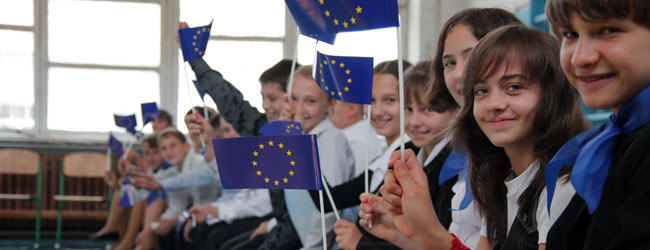|
IN THE SPOTLIGHT |
Eastern Partnership Civil Society Forum
|
|
Eastern Partnership
The Eastern Partnership (EaP) is a policy initiative launched at the Prague Summit in May 2009 that aims to bring the 6 Eastern neighbours - Armenia, Azerbaijan, Belarus, Georgia, Republic of Moldova and Ukraine - closer to the EU. It represents the Eastern dimension of the European Neighbourhood Policy (ENP) and strengthens bilateral relations between the EU and its partners. Source: ENPI Info Centre History of Eastern Partnership Initiative The Eastern Partnership was launched with the ambitious aim of initiating political association and economic integration between the EU and its Eastern Partners. This would imply new association agreements including deep and comprehensive free trade areas and gradual integration in the EU economy.It would also allow for easier travel to the EU through gradual visa liberalisation, accompanied by measures to tackle illegal immigration. Since its launch in 2009, the Eastern Partnership has gone a long way in shaping the agenda of cooperation between the EU and its eastern neighbours and providing a solid framework for sharing expertise and best practices. The initiative has given rise to new platforms for dialogue at the government and expert level (thematic platforms), as well as in the fields of parliamentary and participatory democracy (Euronest; Conference of the Regional and Local Authorities for the Eastern Partnership - CORLEAP). The Joint Declaration of the EaP Summit[1] in Warsaw, held in September 2011 emphasized the strategic importance of the Partnership as a way to deepen and strengthen relations between the EU and the partner countries, to speed up their political association, economic integration and approximation towards the EU and to support their modernization efforts. Eastern Partnership: from Prague to Riga The Eastern Partnership Objectives: EU cooperation with the Eastern Partnership countries is about encouraging political and socio-economic reforms. This means consolidating democracy and pursuing sustainable and inclusive growth for the benefit of citizens. The EU provides support through policy dialogue, the exchange of experience and financial support for reforms in key sectors – justice and human rights, development of rural areas, private sector development and job creation, fight against corruption, integrated border management. Contacts and exchanges between people living in different countries are a key feature of cooperation – for example through student mobility and networks for civil society, the business community and representatives of local authorities. EaP foresees:
The Eastern Partnership is based on commitments to the principles of international law and to fundamental values (notably those enshrined in Council of Europe conventions) including: democracy and rule of law; respect for human rights & basic freedoms; free market economy with sustainable development. How does Eastern Partnership work?The Eastern Partnership has a two-track approach. The bilateral track is designed to foster a closer relationship between the EU and each of the Partner countries. It includes the upgrading of contractual relations towards association agreements; the prospect of negotiating deep and comprehensive free trade areas, progressive visa liberalisation in a secure environment; deeper co-operation to enhance the energy security of the partners and the EU; and support for economic and social policies designed to reduce disparities within each partner country and across borders. Comprehensive institution-building programmes are undergoing in order to improve the capacity of each partner to undertake the necessary reforms. The multilateral track provides a new framework for cooperation and exchange of best practices. Four Eastern Partnership thematic platforms chaired by the European Commission allow for target-oriented sessions and serve for open and free discussions. The four areas of co-operation are:
EaP CSF role in Eastern Partnership The EaP CSF has a specific role in the Eastern Partnership: to serve as a civil society and people-to-people dimension of the initiative that will contribute to democratic and economic transformation of the Partners countries. The four Eastern Partnership thematic platforms have regular (biannual) target-oriented sessions which allow for open and free discussion and the formulation of recommendations. More information on Eastern Partnership EaP Platforms. The Working Groups of the EaP CSF works independently but in parallel to these platforms. The EaP CSF has a permanent participant status to the Platforms and is taking active part in the meetings of the Platform by presenting reports and speeches on a regular basis. The EaP launch gave a strong impetus to the EU’s engagement with civil society. Since the launch of the the EaP, EU support to civil society in the region has more than doubled and has reached some € 63 million for 2010-13 for the six countries concerned. Main results of EaP Flagship InitiativesIn addition, the Eastern Partnership has launched flagship initiatives, which are specific programmes aimed to support objectives of the EaP and achieve tangible results in: 1. Sector reforms supported through EU budget support programmes, complemented by infrastructure projects via the Neighbourhood Investment Facility (NIF). 2. Innovative approach to differentiation (the ‘more for more’ principle). 3. Building institutions involved in the implementation of EU agreements and approximation process through various EU programmes. 4. Increased EU support to civil society. 5. Strengthened regional cooperation through programmes and flagship initiatives. More information about the Eastern Partnership Flagship Initiatives Key documents and presentations [1] Meetings of Heads of State and Government of the Eastern Partnership are |
Project funded by the European Union
![]()







